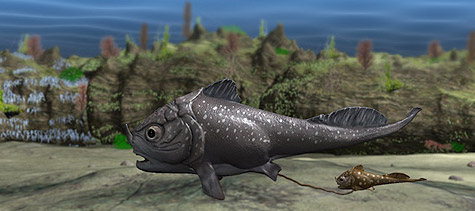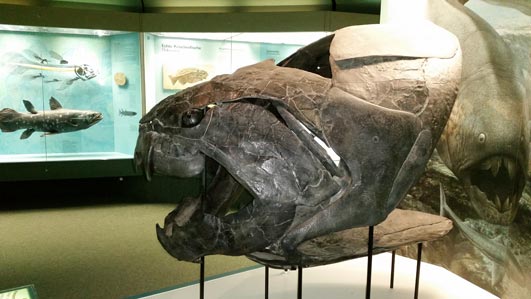A Fishy Tale Indeed – An Amazing Placoderm Parent
Live Birth Fossil – Placoderm gave birth to Live Young
A placoderm parent! A 380-million-year-old fossil placoderm reveals an internal embryo and a mineralised umbilical cord, indicating that these ancient fish gave birth to live young, pushing back the origins of viviparous behaviour by 200 million years.
A team of Australian scientists have claimed that this is one of the most important palaeontological finds and the earliest example of vertebrate sex discovered to date. One of the team’s lead researchers Dr John Long (Museum Victoria) stated:
“This is one of these real eureka moments in science you have once in your lifetime. When you look down the microscope and there it was – an embryo inside a 380-million-year-old fish – and I was blown away by the very thought of this fish giving birth to live young almost 400 million years ago.”
The fossil fish is a member of the now extinct Placodermi Class and has been dated to the Devonian period, otherwise known as the Age of Fishes. The 25 cm long fossil was found in the far north of Western Australia, south east of Fitzroy Crossing in a fantastically fossil rich area known as the Gogo Formation. Approximately 380 million years ago this area of dry, scrub-land was covered by a shallow sea and teemed with life, an environment similar to the Great Barrier reef of Australia to day, the corals that provided much of the habitat were not the scleractinian corals of today, these types of corals first evolved in the Triassic, the corals that dominated this environment were rugose and tabulate corals, two types of coral that went extinct at the end of the Permian period.
The Placodermi
The placoderms were very heavily armoured fishes that possessed bony skeletons and jaws. The head and trunk were encased in a box-like series of bony plates, the group is believed to have evolved sometime in the Silurian and diversified into as many as 200 different genera. Fossils of placoderms have been found in sediments that represent both marine and freshwater environments.
The shales that form the Upper Devonian Gogo Formation were formed in quiet bays, that formed a link between the coral sea and the surrounding coastal areas. The sediments contain superbly preserved fossil fish and other creatures that lived in this ancient sea. These thick deposits contain one of the most diverse collection of animal fossils of the Devonian period with over 25 varieties of placoderms, ray-finned fishes, lobe-fins and lungfish. Such has been the quantity and quality of fossils from this area that a placoderm has been adopted as the official state fish of Western Australia – it is known affectionately as the GoGo fish – official name Mcnamaraspis kaprios.
Preserved as original bone in limestone nodules within the shale, these fossils represent the best preserved early fishes in the world and the site is of huge importance to scientists as they try to piece together the evidence to understand how and why vertebrates moved onto land.
A Placoderm Parent
The fossil showing the embryo was found three years ago, but only after the specimen was placed in an acid bath to help dissolve away the surrounding matrix, was the significance of this particular fossil recognised. Acid preparation is a common technique used by laboratory technicians to help reveal more of a fossil which is surrounded by a limestone matrix. This technique was pioneered by scientists at the Natural History Museum in London and used to help reveal more of dinosaur bones embedded in calcareous rocks.
This particular placoderm, represents a new species and it has been named Materpiscis attenboroughi after Sir David Attenborough, in recognition of his work in the field of Natural History and his help in identifying the Gogo Formation as being of major scientific importance.
“The discovery is certainly one of the most extraordinary fossil finds ever made and changes our understanding of the evolution of vertebrates,” Melbourne-based Dr Long commented.
“The existence of the embryo and umbilical cord within the specimen provides scientists with the first every example of internal fertilisation – that is, sex – confirming that some placoderms had remarkably advanced reproductive biology.”
Once the cleaned and fully prepared fossil was put under a powerful CT scanner at the Australian National University in Canberra, the yolk sac and a major blood vessel inside the umbilical cord could clearly be seen. The fossil provides evidence that the basic body plan that makes up a vertebrate was already present 380 million years ago and sheds light on how placoderms reproduced.
An Artist’s Impression of Materpiscis attenboroughi

Picture credit: Museum Victoria
The paper on this particular specimen, the oldest vertebrate mother known, has just been published in the scientific journal Nature. It seems that some placoderms reproduced in a very similar way to some cartilaginous fish (sharks and rays) who are also viviparous – able to give birth to live young.
Could this be evidence that the sharks and rays shared a common ancestor with the placoderms? The fossil record of vertebrates is particularly poor in the Silurian and Ordovician and scientists are still uncertain as to the relationships between the different Orders of fish. Perhaps this fossil of a female placoderm provides evidence of convergent evolution. Convergent evolution is the development of similar anatomical or morphological characteristics such as the ability to give birth to live young in unrelated groups of animals or plants in response to the same environmental pressures.
An Exhibit Featuring the Most Famous Placoderm of All – Dunkleosteus
Picture credit: Everything Dinosaur
The ability to give birth to fully developed young which had grown up inside the mother for protection would have given such creatures an advantage, helping to ensure the survival of more babies, than those species that laid eggs expelled from the body – oviparous behaviour. There were certainly a great number of predators around ready to feast on any eggs that were found, fish such as the lung fishes, lobe-finned species as well as the large arthropod predators the sea scorpions (eurypterids).
Remarkable Fish Finds
Some other remarkable fish finds have been reported from the Gogo fossil site, including evidence of fish with muscle tissue similar to that which is found in land living vertebrates and an almost 3-D impression of a fish providing information on nerve and circulatory tissue. Such exquisite preservation provides scientists with an opportunity to learn a great deal more about life in the Devonian seas. Another placoderm specimen from the same formation was found in 1986, this fossil shows evidence of three internal embryos and study of the developing babies could provide the Australian team with a wealth of new data on bone formation and the growth of young placoderms.
Unfortunately, any biological advantage life birth gave some of their kind, this was have been outweighed by other factors as the entire family went extinct at the end of the Devonian – perhaps their armoured blunt bodies made them too inefficient swimmers to compete effectively with the tetrapods and the rapidly diversifying other fish families.
Everything Dinosaur stocks a range of prehistoric fish replicas including models of Dunkleosteus. For example, the PNSO model range includes several ancient fish models including prehistoric sharks and a Dunkleosteus figure: PNSO Age of Dinosaurs Figures.


